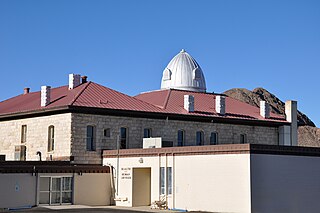
Nye County is a county in the U.S. state of Nevada. As of the 2020 census, the population was 51,591. Its county seat is Tonopah. At 18,159 square miles (47,030 km2), Nye is Nevada's largest county by area and the third-largest county in the contiguous United States, behind Coconino County of Arizona and San Bernardino County of California.
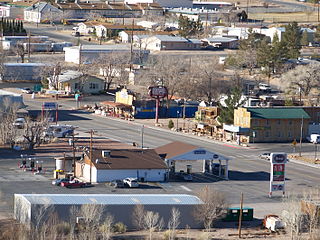
Beatty is an unincorporated town along the Amargosa River in Nye County, Nevada, United States. U.S. Route 95 runs through the town, which lies between Tonopah, about 90 miles (140 km) to the north and Las Vegas, about 120 miles (190 km) to the southeast. State Route 374 connects Beatty to Death Valley National Park, about 8 miles (13 km) to the west.

Tonopah is an unincorporated town in and the county seat of Nye County, Nevada, United States. Nicknamed the Queen of the Silver Camps for its mining-rich history, it is now primarily a tourism-based resort city, notable for attractions like the Mizpah Hotel and the Clown Motel.
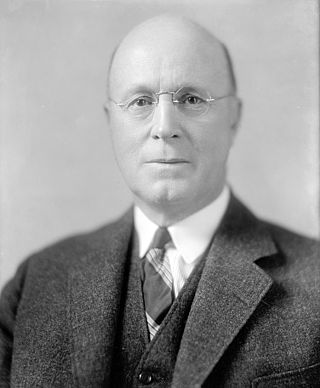
Tasker Lowndes Oddie was an American attorney and politician who served as the 12th Governor of Nevada and a United States Senator. He was a member of the Republican Party.

Rhyolite is a ghost town in Nye County, in the U.S. state of Nevada. It is in the Bullfrog Hills, about 120 miles (190 km) northwest of Las Vegas, near the eastern boundary of Death Valley National Park.

El Rancho Vegas was a hotel and casino at the north end of the Las Vegas Strip in Winchester, Nevada. It opened in 1941, as the first resort on the Strip, known then as part of Highway 91. It was located at what is now the southwest corner of Las Vegas Boulevard and Sahara Avenue. The El Rancho Vegas was conceived by Thomas Hull, who owned several hotels in California and wanted to expand his operations to Las Vegas. He decided to build his new resort along Highway 91, on desert land located just outside of city limits. Hull intended to target motorists traveling from Los Angeles to Las Vegas, although his remote location was met with skepticism.
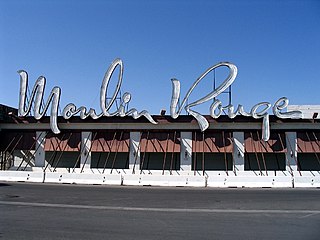
The Moulin Rouge Hotel was a hotel and casino in West Las Vegas, Nevada, that was listed on the U.S. National Register of Historic Places in 1992. Although its peak operation lasted only six months in the second half of 1955, it was the first desegregated hotel casino and was popular with many of the Black entertainers of the time, who would entertain at the other hotels and casinos and stay at the Moulin Rouge.

The Mizpah Hotel is a historic hotel in Tonopah, Nevada, U.S. It is a member of Historic Hotels of America, the official program of the National Trust for Historic Preservation.

The Nye County Courthouse in Tonopah, Nevada is a two-story rusticated stone building. Its Romanesque Revival entrance and pointed dome are unique in Nevada. The courthouse was built following the move of the Nye County seat from Belmont to Tonopah in 1905.
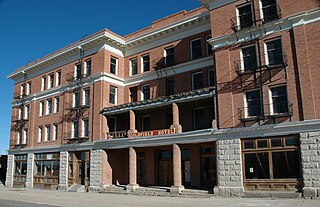
The Goldfield Hotel is a historic four-story building located at the southeast corner of Crook Avenue and Columbia Avenue in Goldfield, Esmeralda County, Nevada. Designed in the Classical Revival style of architecture by Reno architects Morrill J. Curtis (1848–1921) and George E. Holesworth of the firm of Curtis and Morrill, it was built between 1907 and 1908 on the site of two earlier hotels of the same name which had burnt down. Built in a U-shape in order to ensure outside windows for each guest room, the building has its west or main facade extending 180 feet (55 m) along Columbia Street with the north wing fronting 100 feet (30 m) on Crook Avenue and the south wing fronting 100 feet (30 m) along an alleyway. The ground floor exterior facades were built of grey granite stones from Rocklin, California while the interior first floor facade and all upper story facades were built of redbrick. The top floor exterior facades were crowned with a white cornice. On March 4, 1981, it was added to the Nevada State Register of Historic Places. It is a contributing property in the Goldfield Historic District, which was added to the National Register of Historic Places on June 14, 1982.

The Tonopah Liquor Company Building is a historic building located on Main St. in Tonopah, Nevada. The building was constructed in 1906 by the Tonopah Liquor Company. The stone building was designed in the Classical Revival style and features a large pediment with a stone cornice. While the building was one of many stone structures built in Tonopah's early history, it is now one of only four remaining in the town; a local historic survey claimed it to be the most well-crafted of the remaining buildings.
The Tonopah Mining Company House is a historic house located on Queen Street in Tonopah, Nevada. The house was built in 1904 by the Tonopah Mining Company and served as a company house for its employees. The wood-frame house was designed in the Georgian Revival style. The house's design features an entrance porch topped by a gable, three chimneys, boxed eaves, and molded cornices.
The Verdi Lumber Company Buildings are three historic buildings on Main St. in Tonopah, Nevada. The buildings include two two-story lumber sheds, one open and one enclosed, and a storage building. The buildings were constructed in 1911, the year the Verdi Lumber Company was incorporated. A branch of the Tonopah and Goldfield Railroad connected to the site, allowing the company to transport its products. The company eventually became the largest lumber company in central Nevada. The three buildings are the only remaining buildings from the company's Tonopah facilities.
The Board and Batten Cottage is a board and batten house located on Prospect Street in Tonopah, Nevada. The house was built in 1909. Its design features a T-shaped plan with symmetrical features, a hipped roof, and molded and boxed cornices along the roof line. The house originally had two porches, including one along the entire front of the building, but both have been removed. Board and batten homes were common in early Tonopah, and the house is a relatively intact example of the style.

The Stone Jail Building and Row House are two adjacent stone buildings located on Water Street in Tonopah, Nevada. The jail was built in 1903 and the adjacent row house in 1908. Both building were at one time used as a brothel. The buildings were added to the National Register of Historic Places in 1982.

The Brann Boardinghouse is a historic boarding house located on Bryan Street in Tonopah, Nevada. The 2+1⁄2-story building is the largest wood-frame residence in Tonopah. The building's design includes a two-story porch with a balustrade along the second floor, molded cornices, boxed eaves, and a hipped roof; the inside has 18 rooms connected by two central hallways, one on each floor. Mrs. A.J. Brann built the boarding house in 1906. It was one of many boarding houses built in Tonopah to house the community's miners. The house is now one of only four boarding houses remaining in Tonopah.

The H. A. McKim Building is a historic building located at the southwest corner of Main and Oddie Streets in Tonopah, Nevada. The building was constructed in 1906 for Hiram Albert McKim, who had begun a mercantile business in the town two years prior. Carpenter craftsman J. J. Finley and stonemason E. E. Burdick constructed the building, a two-story stone building designed in the Classical Revival style. The building's design includes an ashlar front facade, a pediment at its parapet, second-story windows ornamented with voussoirs and keystones, and a metal cornice. McKim's store ultimately became the largest mercantile store in central Nevada.

The Frank Golden Block, at Brougher and Main Sts. in Tonopah, Nevada is a historic building that was built in 1902. It was listed on the National Register of Historic Places in 1982.

Hotel Nevada and Gambling Hall, also known as the Historic Hotel Nevada and Gambling Hall, is a hotel and casino located at 501 Aultman Street in Ely, Nevada.


















